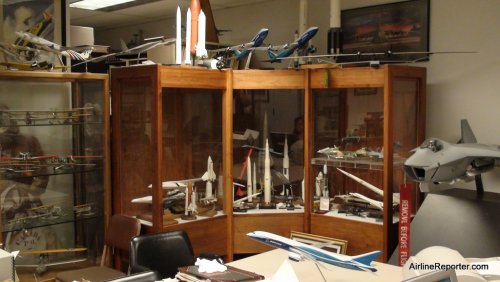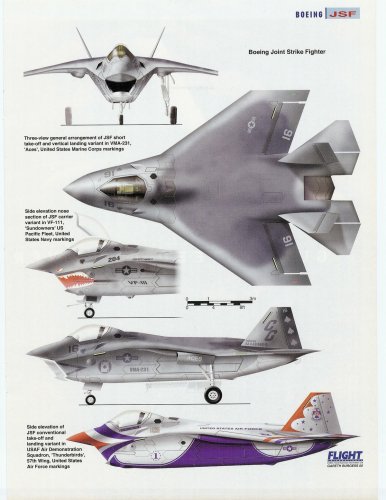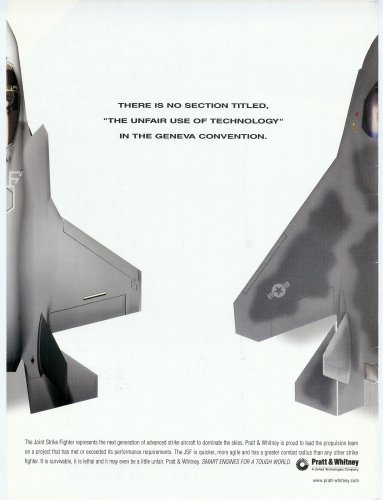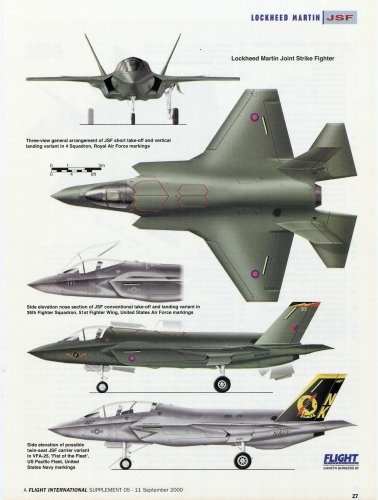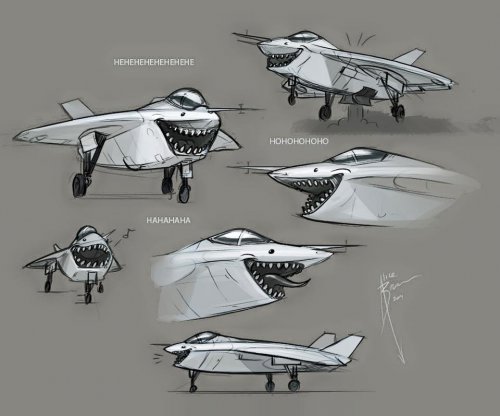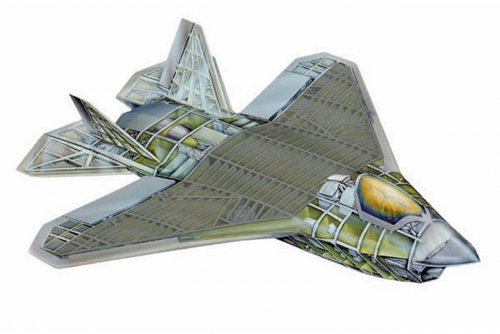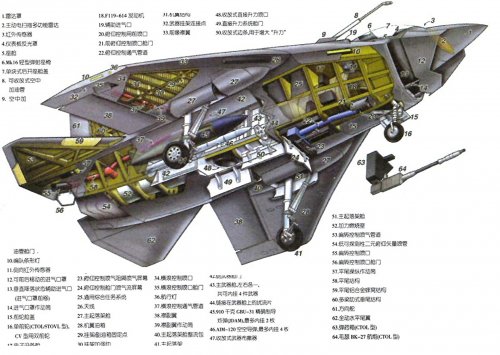You are using an out of date browser. It may not display this or other websites correctly.
You should upgrade or use an alternative browser.
You should upgrade or use an alternative browser.
Boeing JAST / JSF / X-32 /PWSC F-32 projects
- Thread starter Archibald
- Start date
- Joined
- 25 June 2009
- Messages
- 14,717
- Reaction score
- 6,039
I knew we'd discussed the "Musketeer" bit before, and here it is:
http://www.secretprojects.co.uk/forum/index.php/topic,238.msg90248.html#msg90248
A quick browse in Google results shows that many people on other forums derided and ridiculed the name "Musketeer" when word came out it might designate the F-35.
I thought it was a pretty cool name myself, implying notions of chivalry, quickness and precision, loyalty, adventure and working together...
http://www.secretprojects.co.uk/forum/index.php/topic,238.msg90248.html#msg90248
A quick browse in Google results shows that many people on other forums derided and ridiculed the name "Musketeer" when word came out it might designate the F-35.
I thought it was a pretty cool name myself, implying notions of chivalry, quickness and precision, loyalty, adventure and working together...
ADVANCEDBOY
ACCESS: Secret
- Joined
- 3 February 2011
- Messages
- 335
- Reaction score
- 89
Actually, I find X-32 to be very professionally designed. It doesn`t have any amateur signature in it. Shapes are well thought out and balanced. What is a bit puzzling is that visual mass( my own invention which is based on observations in nature how species evaluate each others genetical health via visual porportions of visual mass.) in front part of the airplane seems to be slightly too much forward. I would probably pull the nose part slightly forward and move the visual bulk of the fuse slightly backwards, relieving the tension in air intake area.
And I think The Air force should have gone for procurement of both airplanes simultaneously, keeping both involved companies hostages to each others competition. In this scenario noone of the companies could be able to jack up prices, abusing the lack of competing alternatives. My 0.2 inflation affected cents.
And I think The Air force should have gone for procurement of both airplanes simultaneously, keeping both involved companies hostages to each others competition. In this scenario noone of the companies could be able to jack up prices, abusing the lack of competing alternatives. My 0.2 inflation affected cents.
- Joined
- 1 April 2006
- Messages
- 11,358
- Reaction score
- 10,112
That's just a model of Preferred Weapon System Concept (PWSC) F-32B, i.e. production F-32B how it was envisioned. What's so unusual about it?sienar said:Interesting model of what appears to be an F-32 variant.
Any info on this?
- Joined
- 1 April 2006
- Messages
- 11,358
- Reaction score
- 10,112
RIVET? what has _it_ to do with it?Sundog said:The problem with the RIVET design is the losses in the intake and the exhaust due to having to turn the flow 180 degrees.
flateric said:That's just a model of Preferred Weapon System Concept (PWSC) F-32B, i.e. production F-32B how it was envisioned. What's so unusual about it?sienar said:Interesting model of what appears to be an F-32 variant.
Any info on this?
The air intake differs in the artist's concept and model for the STOVL configuration from the X-32. Also remember that the F-35 designation skipped numbers in the numerical sequence of fighter designations so the Boeing JSF proposal probably shouldn't be called the F-32 or F-32B. X (Experimental) designations are not directly related to F (Fighter) designations. The expected designation for JSF was F-24.
See:
"'Missing' USAF/DOD Aircraft Designations"
http://www.designation-systems.net/usmilav/missing-mds.html
"Non-Standard DOD Aircraft Designations"
http://www.designation-systems.net/usmilav/nonstandard-mds.html#_MDS_F35
- Joined
- 3 October 2007
- Messages
- 1,960
- Reaction score
- 1,192
ADVANCEDBOY said:Actually, I find X-32 to be very professionally designed. It doesn`t have any amateur signature in it. Shapes are well thought out and balanced. What is a bit puzzling is that visual mass( my own invention which is based on observations in nature how species evaluate each others genetical health via visual porportions of visual mass.) in front part of the airplane seems to be slightly too much forward. I would probably pull the nose part slightly forward and move the visual bulk of the fuse slightly backwards, relieving the tension in air intake area.
And I think The Air force should have gone for procurement of both airplanes simultaneously, keeping both involved companies hostages to each others competition. In this scenario noone of the companies could be able to jack up prices, abusing the lack of competing alternatives. My 0.2 inflation affected cents.
The thing is, Lockheed's performance in the demonstrations was so totally dominant, there's no way they could justify selecting both. They demonstrated everything they promised and then some. Boeing's design while innovative suffered from the situation that among other things they were going to have to do an extensive redesign from the X-32 in any developmental version. They were in effect espousing the Microsoft philosophy, "Don't worry, we'll fix it in the next release" (as opposed to Apple's "You didn't need to do that anyway").
ADVANCEDBOY
ACCESS: Secret
- Joined
- 3 February 2011
- Messages
- 335
- Reaction score
- 89
By allowing them to fix things, and catch up, we would have let them accumulate expertise later to be poured into 6th gen platform. Besides, more people would be employed and the price increase of the sole winner of the programme would be made harder. And nothing improves a product bettter than engineering diversity and its consequent cross pollination of engineers and their ideas among companies. This is how you get a superstrong core of industrial engineering in Japan, be it industrial robots, electronics components or optics. A strong industrial sector is never characterised by a single hit or miss product but rather a whole plethora of market tailored products that allow a leverage of substitute products once an existing platform is rendered obsolete , too costly or ineffective.
- Joined
- 3 June 2011
- Messages
- 18,296
- Reaction score
- 12,109
ADVANCEDBOY said:By allowing them to fix things, and catch up, we would have let them accumulate expertise later to be poured into 6th gen platform. Besides, more people would be employed and the price increase of the sole winner of the programme would be made harder. And nothing improves a product bettter than engineering diversity and its consequent cross pollination of engineers and their ideas among companies. This is how you get a superstrong core of industrial engineering in Japan, be it industrial robots, electronics components or optics. A strong industrial sector is never characterised by a single hit or miss product but rather a whole plethora of market tailored products that allow a leverage of substitute products once an existing platform is rendered obsolete , too costly or ineffective.
Their situation would have made the F-35's look like rainbows and unicorns. Had the X-32 been given the contract undoubtedly the F-32B would have already been cancelled and the naysayers would be whining about why we didn't select the "proven superior" X-35 and "the last fighter Boeing built was the P-26 pea-shooter" etc. ad nauseam. If there's a group that perpetually suffers from "the grass is always greener" syndrome it's internet fanbois.
Anyone who claims that proceeding with both the X-32 and the X-35 programs is good for competition that will lower prices and increase innovation need look no further than the United State Navy's LCS program. The Navy decided to go forward with both the General Dynamics/Austal and Lockheed Martin designs in the LCS program. They believed that competition between the two teams would lead to lower prices and increased innovation because later purchases of ships would be determined by contractor performance.
There are also those who believe that industry consolidation leads to lower prices because of economies of scale, cheaper financing, and greater bargaining power over prices from suppliers. In any case, it's the way of capitalism that mature industries will consolidate and such consolidation is considered natural.
Further, jacking up prices just to increase profit margins is considered contractor fraud and could lead to criminal proceedings against a company and its officers.
There are also those who believe that industry consolidation leads to lower prices because of economies of scale, cheaper financing, and greater bargaining power over prices from suppliers. In any case, it's the way of capitalism that mature industries will consolidate and such consolidation is considered natural.
Further, jacking up prices just to increase profit margins is considered contractor fraud and could lead to criminal proceedings against a company and its officers.
sferrin said:Their situation would have made the F-35's look like rainbows and unicorns. Had the X-32 been given the contract undoubtedly the F-32B would have already been cancelled and the naysayers would be whining about why we didn't select the "proven superior" X-35 and "the last fighter Boeing built was the P-26 pea-shooter" etc. ad nauseam. If there's a group that perpetually suffers from "the grass is always greener" syndrome it's internet fanbois.
In fairness, don't forget the Boeing XF8B (Model 400), which was the last fighter built by Boeing before the X-32. Boeing built three prototypes.
- Joined
- 11 March 2006
- Messages
- 8,618
- Reaction score
- 3,759
From the X-32 over X-32/F-35 this thread is somewhat drifting to F-35 thread. Perhaps we can
stay to the X-32 topic and post F-35 related things in the "F-35 No Holds Barred topic" ?
( http://www.secretprojects.co.uk/forum/index.php/topic,537.0.html ).
Could prevent irritations and discussions here, that perhaps would endanger this thread.
stay to the X-32 topic and post F-35 related things in the "F-35 No Holds Barred topic" ?
( http://www.secretprojects.co.uk/forum/index.php/topic,537.0.html ).
Could prevent irritations and discussions here, that perhaps would endanger this thread.
ADVANCEDBOY
ACCESS: Secret
- Joined
- 3 February 2011
- Messages
- 335
- Reaction score
- 89
Triton, it is easy to follow if consolidation is detrimental or beneficial to the economy and industries as such. We have to follow the pattern of the 2 greatest industrial manufacturers on earth- Japan and Germany. Has their high precision industrial base been depleted by eradication of diversity and amount of companies involved due to mergers. As neither of these 2 countries resort to this tactics, it must be considered to the detriment of long term economical planning to merge various companies into one. Mergers are usually a sign of weakness and inability to manage complex engineering tasks in-house. It is especially risky when a foreign affiliate is merged into the mainframe, which leads to massive layoffs, outsourcing and import component overtake.If a company A manufactures 5 products and company B manufacture 5 products. After a merger they will manufacture most likely 7 products, which is a result of overlapping product range, obsolete products within a portfolio bin and cost reduction. By manufacturing less products, we need less highly skilled workforce( high purchasing power), we reduce our national ability to compete and we endanger the manufacturing process itself by leading to monopoly situation where a single manufacturer within a sector dictates pricing strategies and sleeps on obsoletness laurels. if you think that constant increase of product complexity requires acquisitions of various subcontractors, then look no further than Toyota. A country that can create an industrial robot , a CNC machine and then create a complex product using tools built in their own country by their own companies is considered a superb example of manufacturing supremacy. My 0.2 cents about consolidation.
- Joined
- 2 August 2006
- Messages
- 3,253
- Reaction score
- 1,518
flateric said:RIVET? what has _it_ to do with it?
That's a result of my iPad going to the wrong page. It's a response to a question on page 1, though I thought I was on the last page. The numbers are small and sometimes when I hit a number or link the touch screen thinks I'm picking something else.
- Joined
- 21 April 2009
- Messages
- 13,721
- Reaction score
- 7,604
ADVANCEDBOY said:Triton, it is easy to follow if consolidation is detrimental or beneficial to the economy and industries as such. We have to follow the pattern of the 2 greatest industrial manufacturers on earth- Japan and Germany. Has their high precision industrial base been depleted by eradication of diversity and amount of companies involved due to mergers. As neither of these 2 countries resort to this tactics, it must be considered to the detriment of long term economical planning to merge various companies into one. Mergers are usually a sign of weakness and inability to manage complex engineering tasks in-house. It is especially risky when a foreign affiliate is merged into the mainframe, which leads to massive layoffs, outsourcing and import component overtake.If a company A manufactures 5 products and company B manufacture 5 products. After a merger they will manufacture most likely 7 products, which is a result of overlapping product range, obsolete products within a portfolio bin and cost reduction. By manufacturing less products, we need less highly skilled workforce( high purchasing power), we reduce our national ability to compete and we endanger the manufacturing process itself by leading to monopoly situation where a single manufacturer within a sector dictates pricing strategies and sleeps on obsoletness laurels. if you think that constant increase of product complexity requires acquisitions of various subcontractors, then look no further than Toyota. A country that can create an industrial robot , a CNC machine and then create a complex product using tools built in their own country by their own companies is considered a superb example of manufacturing supremacy. My 0.2 cents about consolidation.
The so-called 'death' of US manufacturing is much exaggerated. Most of what you have written tells a partial story. US manufacturing has fallen steeply as a percentage of GDP but the US manufacturing sector is larger than Germany and Japan's combined!
In 2012 the dollar values, in equivalent USD, was
1) US $4.591 Trillion
2) Germany $1,479 Trillion
3) Japan $2.948 Trillion
While it is true that Germany and Japan have larger manufacturing sectors AS A percentage of their home economies the US is still a major and important manufacturer and more importantly is still the greatest innovator in the world. Asia for example manufactures US products, the invention came first the assembly line second.
You can only make a decision with the facts and the cost estimates that you have when you make it. You can't go back in a time machine and re-make the decision. At the time, the Lockheed Martin X-35 was the superior airplane to the Boeing X-32 and there was expected to be 80% parts commonality between the three variants--F-35A, F-35B, and F-35C. I don't believe that there is any evidence to suggest that the Department of Defense or Lockheed Martin intentionally deceived decision-makers of the complexity of the JSF project. As they say, hindsight is 20/20.
As for consolidation in the aerospace industry, Lockheed Martin abandoned plans for a $8.3 billion merger with Northrop Grumman on July 16, 1998, due to government concerns over the potential strength of the new group; Lockheed/Northrop would have had control of 25% of the Department of Defense's procurement budget. European Aeronautic Defence and Space Company N.V. (EADS) and BAE Systems abandoned their plans for a proposed 35 billion euro (US$45 billion) merger on October 10, 2012 due to objections by the German government. EADS is going to be re-named next year to Airbus Group. So regulators do step in when they believe that consolidation will stifle competition.
As for consolidation in the aerospace industry, Lockheed Martin abandoned plans for a $8.3 billion merger with Northrop Grumman on July 16, 1998, due to government concerns over the potential strength of the new group; Lockheed/Northrop would have had control of 25% of the Department of Defense's procurement budget. European Aeronautic Defence and Space Company N.V. (EADS) and BAE Systems abandoned their plans for a proposed 35 billion euro (US$45 billion) merger on October 10, 2012 due to objections by the German government. EADS is going to be re-named next year to Airbus Group. So regulators do step in when they believe that consolidation will stifle competition.
ADVANCEDBOY said:Actually, I find X-32 to be very professionally designed. It doesn`t have any amateur signature in it. Shapes are well thought out and balanced. What is a bit puzzling is that visual mass( my own invention which is based on observations in nature how species evaluate each others genetical health via visual porportions of visual mass.) in front part of the airplane seems to be slightly too much forward. I would probably pull the nose part slightly forward and move the visual bulk of the fuse slightly backwards, relieving the tension in air intake area.
And I think The Air force should have gone for procurement of both airplanes simultaneously, keeping both involved companies hostages to each others competition. In this scenario noone of the companies could be able to jack up prices, abusing the lack of competing alternatives. My 0.2 inflation affected cents.
The X-32 has the compact brawn of a Wildcat or a Bearcat, particularly the STOVL variant is not far off the dimensions of the A-4 or Harrier. So something punchy and brawny yet small like Badger, Lynx, Bobcat or Wolverine comes to mind for me.
Relieving the tension as you put it is about destroying what little Area Rule it has, while also ignoring the certainty that that fan has to be right where it's at for the liftscreen to operate effectively. And the weapons bays have to fold around or behind that.
This is the Achilles Heel of the X-32/F-32 in that, to get the kind of IRT power needed for STOVL, you had to have a mass flow which could only be satisfied by a fan closer to the F101 than the F100 in diameter.
That fan is running off a core which has to also have enough kick to punch the jet through the Mach and the resultant stochiometrics push you up towards a TSFC on the order of 1.
This made the X-32 a fantastic transonics performer (52,000lbf vs. 40,000 on the X-35), by all accounts dwarfing the F-35s up and away capabilities. But it also meant that the jet was always going to be shortlegged. A fact which likely got worse when the '1,500lbs of structural weight savings' on the PWSC came out of 20-25% chord reduction at the wingroot.
The Marines should have remembered that they had A-4s long before -and after- they had AV-8A-C and the F/A-18A-D, long after they switched to the AV-8B.
The problem is that STOVL is a political tool as much as a tactical one and thus it 'never occurred to them' that a 300 knot escort for a 200 knot V-22 (same margin as AH-1 had over UH-1 in Vietnam) could be something other than a Harrier could justify a _hull change_ in their thru deck helo cruisers with an idea more akin to a dual tramway CVL/SCS type ship.
So that they could continue to support the USN with proper CATOBAR (F-35B is totally incompatible with angle-deck anything) aircraft while having the option to '12 per side' support a real squadron deployment _with support missions_ like the E-2D, KA-18E and EA-18G right out of the gate. Or maintained a helo-side for traditional Marine hurry up coastal interventions.
If they had gone with such a 'radical' idea, the entire F119-PW-614 would have been tossed in favor of something like the F414 or even an F124 class engine, along with canards and ESTOL FLCS effectors.
Engine in the back means inlet duct over rather that between weapons bays and so you get something a lot closer to what the Boeing ATF concept looked like, only cleaner.
The thing is, Lockheed's performance in the demonstrations was so totally dominant, there's no way they could justify selecting both. They demonstrated everything they promised and then some. Boeing's design while innovative suffered from the situation that among other things they were going to have to do an extensive redesign from the X-32 in any developmental version. They were in effect espousing the Microsoft philosophy, "Don't worry, we'll fix it in the next release" (as opposed to Apple's "You didn't need to do that anyway").
IMO, given the huge industry/service test experience base and the laughable 45-50 million dollars PAUC mumbled by Roche at the 2001 contract announcement, it was impossible for the Government or LM _not_ to have known from the outset that this was an unbuildable concurrency problem.
Hence LMs major push to get the F-35A into production by 2012 'for export' as a profit base while they turned their limited SDD team to the next variant.
The USAF performed a hostile takeover on DARPA for J-UCAS and then cancelled it so the notion that we couldn't afford a two jet program on 'the eve of a major war in SWA' is ludicrous, not least because the UCAV would have been the better operational choice (loiter + loiter + CPFH) anyway.
Where you have upwards of a third (ATF) the program costs dedicated to electronics architectures anyway, the notion that iron bird X-jets that don't even structurally represent the production models can somehow be used as one stop shopping justification for downselect on a ONE TRILLION dollar program (keeping in mind it was only supposed to be 220 billion in 1997) when everyone from the CRS to the CBO are screaming the technology base just isn't there is also ludicrous.
Since we were already collapsing multiple (F/A-18, AV-8B, F-16, A-10) programs into half as many follow-ons, there was no shame in deciding that it would be two individual program competitors. One for the nightmare of STOVL and one for the CTOL/CVTOL mission.
Such might has even kept the program on schedule if not budget.
The real key here is numbers. The USAF didn't, in 2001 when O'Hanlon did his study and certainly does not now, need 2,400 or 1,763 or even 1,200 jets. It needs 500. Tops. The USN and Marines need 700, between them. Add 500 more from foreign sales and you have a believable neckdown of all the Gen-3/4 (MiG-21, F-4 and F-5 as well as Teeners) platforms as the world transition to a post Cold War existence with half as many platforms.
That is where you scale your production and the level of technology insert on things like STOVL and Cyber and Stealth. Do this properly and you can afford to both support the industrial base (Boeing has nothing now that the McDonnell properties are aging out and nobody wants a retread 60s Eagle or 70s Hornet) and provide competitive honesty with dual programs funded to the tune of maybe TEN, not One Hundred, SDD airframes.
Everything we have been told about the JSF program has largely been based on carefully worded prevarications.
The sad part being that The Services got themselves well and truly stuck-in (Fox to Tar Baby) on the concept of having another big acquisition program with no foe worthy of it's cost in sight. They thought that they could fix as they flew without Congress daring to suspend the effort because...'Everybody or Nobody' it was so important to the recap of all.
But they didn't count on real engineering issues (and particularly PDR/CDR weights) to become a program stopper with one name for three airframes.
As the saying goes: "Sales sells the lie, Marketing believes it." Marketing in this case being overhyped customers.
That is why we need to make sure that not only is there never a 'sole source' solution involved that so fixates on justifying itself as to _generate the crisis_ which puts all other major Tacair alternative options (like CAPES and F-22 and Golden Eagle).
By instituting a two-tier, limited commitment, X-Plane and PWSC evaluation system.
But also that the _acquisition agency_ responsible for writing the specs and evaluating their achieved execution has absolutely no confirmation bias attendant upon user service or industrial influence. It must be totally separate, upon pain of brutally long prison terms. Something like the DSAC mixed with NASA Ames and DARPA might work.
The Customer may be the victim of believing the market hype. But we are the ones with Buyer's Remorse.
Does anyone remember a series of side elevation views of the X-32 PWSC with various user markings? I particularly recall a shark mouth F-32B. Might have been in Flight Global or Flight International. Sometime in the 2000-2002 period?
Thank You.
Thank You.
- Joined
- 3 June 2011
- Messages
- 18,296
- Reaction score
- 12,109
robunos said:This the one...?
cheers,
Robin.
Funny thing is those almost look like Hank Caruso drawings - but it really would have looked like that.
- Joined
- 1 May 2007
- Messages
- 2,593
- Reaction score
- 1,958
pedrospe said:Great picture,thanks a lot for sharing,is there a navy or air force scheme of the f-32, with this resolution??
best regards
Pedro
The only thing is this advert...
cheers,
Robin.
Attachments
- Joined
- 3 June 2006
- Messages
- 3,092
- Reaction score
- 3,939
If I remember correctly, the second page of that add, which robunos posted at #184, showed X-35 / F-35 schemes i.e. the famous one side scheme showing the two-seater X-35C / F-35C.
- Joined
- 1 May 2007
- Messages
- 2,593
- Reaction score
- 1,958
fightingirish said:If I remember correctly, the second page of that add, which robunos posted at #184, showed X-35 / F-35 schemes i.e. the famous one side scheme showing the two-seater X-35C / F-35C.
Yes, you're correct, and here it is, though it's really off-topic for this thread...
cheers,
Robin.
Attachments
- Joined
- 1 May 2007
- Messages
- 2,593
- Reaction score
- 1,958
sferrin said:robunos said:This the one...?
cheers,
Robin.
Funny thing is those almost look like Hank Caruso drawings - but it really would have looked like that.
That was the idea! The enemy would be too busy laughing to fight back.... ;D
cheers,
Robin
pedrospe said:Great picture,thanks a lot for sharing,is there a navy or air force scheme of the f-32, with this resolution??
best regards
Pedro
Remember that the Mission-Design-Series (MDS) number for the F-35 is out of sequence, there is no relationship between Experimental (X- numbers) and Fighter (F- numbers). The next available F number was believed to be 24 as in F-24. Lockheed Martin even referred to its JSF aircraft inhouse as the F-24. The F-35 designation came as a surprise to many and is believed to be in error.
Refer to:
http://www.designation-systems.net/usmilav/nonstandard-mds.html#_MDS_F35
- Joined
- 3 June 2011
- Messages
- 18,296
- Reaction score
- 12,109
Triton said:The F-35 designation came as a surprise to many and is believed to be in error.
Refer to:
http://www.designation-systems.net/usmilav/nonstandard-mds.html#_MDS_F35
Definitely an error. I heard the guy making the announcement and somebody asked him what it would be called and he was all, "uhhh. . . F-35?" And it stuck.
Colonial-Marine
UAVs are now friend, drones are the real enemy.
- Joined
- 5 October 2009
- Messages
- 1,463
- Reaction score
- 1,316
Does anybody recall mention of the numbers they expected/needed for the lift system of the production Boeing JSF? The X-32B made a rather poor showing for itself in STOVL trials but I recall advocates of the design claiming something about 56,000 lbs of thrust.
Seems to me like the "F-32" would have just as many troubles to overcome as the F-35 has had to face.
Seems to me like the "F-32" would have just as many troubles to overcome as the F-35 has had to face.
- Joined
- 2 August 2006
- Messages
- 3,253
- Reaction score
- 1,518
Colonial-Marine said:Does anybody recall mention of the numbers they expected/needed for the lift system of the production Boeing JSF? The X-32B made a rather poor showing for itself in STOVL trials but I recall advocates of the design claiming something about 56,000 lbs of thrust.
Seems to me like the "F-32" would have just as many troubles to overcome as the F-35 has had to face.
The main problem the X-32 had in STOVL was what is known as "Hot Gas Re-ingestion." That can happen when a design of this type is hovering the hot engine exhaust gets sucked back into the inlet. Thrust is partly created by the differential in temperature of what's coming in to what's going out. When this happens the engine loses thrust and it can damage the engine due to exceeding the temperature limits of the engine. The X-35 layout had the fan up front which creates a flow that blocks the exhaust from making it up to the inlet. It also generated more thrust in the hover.
I think what Boeing should have done is argued that the X-32 can perform a super STOL landing in the space needed for either it or the X-35 to take off and, as such, vertical landing wasn't really needed. When you consider the F-35 will have a limited vertical landing capability without special pads to land on, it wouldn't have been such a bad argument. In fact, Britain is looking at performing STOL landings on their CV's in order to have a higher bring back weight.
They probably still would have lost the competition due to not meeting the requirements, but I think it would have been a better argument than removing parts from the X-32 in order to lighten it for the hover. Because, with the trouble the X-32 had hovering, the F-32 would have had even more trouble since aircraft gain weight when going from a limited life prototype to a full functioning operational aircraft.
Sundog said:Colonial-Marine said:Does anybody recall mention of the numbers they expected/needed for the lift system of the production Boeing JSF? The X-32B made a rather poor showing for itself in STOVL trials but I recall advocates of the design claiming something about 56,000 lbs of thrust.
Seems to me like the "F-32" would have just as many troubles to overcome as the F-35 has had to face.
The main problem the X-32 had in STOVL was what is known as "Hot Gas Re-ingestion." That can happen when a design of this type is hovering the hot engine exhaust gets sucked back into the inlet. Thrust is partly created by the differential in temperature of what's coming in to what's going out. When this happens the engine loses thrust and it can damage the engine due to exceeding the temperature limits of the engine. The X-35 layout had the fan up front which creates a flow that blocks the exhaust from making it up to the inlet. It also generated more thrust in the hover.
I think what Boeing should have done is argued that the X-32 can perform a super STOL landing in the space needed for either it or the X-35 to take off and, as such, vertical landing wasn't really needed. When you consider the F-35 will have a limited vertical landing capability without special pads to land on, it wouldn't have been such a bad argument. In fact, Britain is looking at performing STOL landings on their CV's in order to have a higher bring back weight.
They probably still would have lost the competition due to not meeting the requirements, but I think it would have been a better argument than removing parts from the X-32 in order to lighten it for the hover. Because, with the trouble the X-32 had hovering, the F-32 would have had even more trouble since aircraft gain weight when going from a limited life prototype to a full functioning operational aircraft.
My guess is that the X-32 would have come out second to the X-35 in STOL as well. As you noted, the X-35 could generate more vertical lift from the same engine because some of it was provided by a fan rather than jet thrust. The Pegasus provided a similar benefit, in that the thrust from the forward nozzles was provided by a fan, albeit not at as low a disc loading as the X-35 fan.
red admiral
ACCESS: Top Secret
- Joined
- 16 September 2006
- Messages
- 1,792
- Reaction score
- 2,340
sferrin said:Consider that the X-32 had to go to a sea-level location and leave parts on the ground just to do a vertical landing.
Whereas X-35 left the entire weapon bays out and hence shedded loads of fuselage structural mass in addition to transonic drag...
Not a like with like comparison
- Joined
- 3 June 2011
- Messages
- 18,296
- Reaction score
- 12,109
red admiral said:sferrin said:Consider that the X-32 had to go to a sea-level location and leave parts on the ground just to do a vertical landing.
Whereas X-35 left the entire weapon bays out and hence shedded loads of fuselage structural mass in addition to transonic drag...
Not a like with like comparison
On the other hand they didn't scrap the entire X-35 design like they did with the X-32.
Similar threads
-
McDD/Northrop/BAe ASTOVL/MRF/JAST/JSF studies
- Started by Antonio
- Replies: 255
-
Alternate history: Boeing won JSF
- Started by helmutkohl
- Replies: 45
-
Boeing Multi-Role Fighter (MRF) studies
- Started by Sundog
- Replies: 39
-
US Navy 1960-1963 VAX supersonic A-4 replacement program
- Started by Skybolt
- Replies: 49
-

